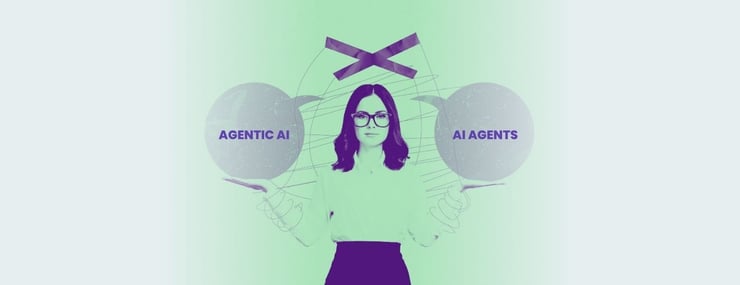Agentic AI refers to intelligent systems that plan, act, learn, and adapt autonomously toward a goal, much like digital coworkers. AI agents, on the other hand, are individual components that carry out specific tasks, often triggered by humans or rules. In enterprise environments, the best results come when agentic AI orchestrates multiple agents.
We get it, when thinking about AI agents vs agentic AI, it sounds like two ways of saying “robots who do your work.” But in reality, these terms belong in different corners of the AI universe.
One is a mindset. The other is a machine. One writes an idea. The other turns it into action. If you're aiming to build a team of smart digital coworkers, it's crucial to understand which team members work best together and why.
Let’s dive into the difference between agentic AI and AI agents, without the fluff, jargon, or awkward tech metaphors (okay, maybe one or two, old habits die hard).
Definition
Agentic AI vs AI Agents: What are they?
In short:
- An AI agent is a doer. It executes predefined tasks. It’s narrow in focus and usually reactive.
- Agentic AI is a thinker and planner. It sets goals, makes decisions, adapts, and learns. It orchestrates multiple agents to achieve outcomes.
You can think of agentic AI as the conductor of an orchestra. It doesn’t play the instruments; that’s what the AI agents do. But it reads the room, adjusts the tempo, and guides the performance to create a harmonious experience.
Now, let’s look at these two in more depth:
What Are AI Agents?
Picture a coworker who reads the situation, makes a decision, takes the right steps to solve a problem, and then learns from it for next time.
Now remove their need for snacks, meetings, and PTO.
That’s an AI agent. AI agents are digital entities built to perceive, reason, and act. They don’t just respond, they take initiative. They handle real-world tasks across various tools and systems with a level of autonomy that distinguishes them from the average chatbot.
Whether you’re managing supply chain exceptions, customer queries, or HR onboarding, autonomous AI agents can be deployed to manage the end-to-end flow, not just fire off canned responses.
These aren’t assistants. These are your next team members, smart digital coworkers trained for enterprise work.
What Is Agentic AI?
Now here’s where things get interesting.
Agentic AI refers to an AI system's ability to exhibit goal-directed behavior. It's not a job title, it’s a trait. A quality. A style of functioning.
In other words, agentic AI is AI that behaves as if it has goals, preferences, and decision-making autonomy, even if it’s still dependent on human input.
Large Language Models like OpenAI's GPT, available through Microsoft Azure, suggest how to respond to an email. That’s agentic AI in action. But unless it sends the email, updates your CRM, and books a follow-up call on its own, it’s not an AI agent.
Agentic AI is the “thinking,” while AI agents are the “doing.” One makes suggestions, the other executes.
What are the key differences between AI agents and agentic AI?
|
Feature |
AI Agents |
Agentic AI |
|
Definition |
Autonomous systems that act toward specific goals |
AI that demonstrates goal-directed behavior |
|
Autonomy |
High – can execute tasks independently |
Low to moderate – needs prompting |
|
Function |
Performs multi-step processes |
Suggests, generates, analyzes |
|
Enterprise Role |
Workflow execution and automation |
Language understanding, ideation, and content creation |
|
Examples |
AI agents can automate HR or IT workflows |
An LLM-based assistant that summarizes customer feedback |
Why Understanding the Difference Between AI Agents and Agentic AI Matters for Enterprise Automation
If you’re leading a digital transformation initiative or rolling out automation at scale, understanding this distinction will save you time, budget, and a few awkward project post-mortems.
Expectations Need to Match Reality
Expecting a Gen AI assistant to run payroll autonomously is like expecting your GPS to also drive the car. You’ll get directions, but you still have to do the work. That’s where autonomous AI agents step in.
Agentic AI Is a Building Block, Not the Blueprint
Agentic AI is essential for natural interactions, content generation, and contextual understanding. But without orchestration, memory, and tool integrations, it won’t cross the finish line on its own.
Smart Digital Coworkers Need Both
You don’t want AI that just talks. You want AI that thinks, acts, and learns. When you combine the reasoning of agentic AI with the structure of AI agents, you get true enterprise-ready automation.
KEY TAKEAWAY
Real Use Cases To Understand The Differences Between Agentic AI and AI Agents Across Departments
To better understand the difference and connection between AI agents and agentic AI, we’ll present some real-world use cases across various departments. In this case, we’ll take a closer look at customer complaints and employee onboarding.
Managing a customer complaint with Agentic AI and AI agents
If you're building automation into your customer support operations, understanding how agentic AI and AI agents handle high-pressure moments, such as complaints, is critical.
Agentic AI
This is your strategic assistant, the one who reads between the lines.
- Analyzes the tone and sentiment of the customer’s complaint to understand urgency and emotional state.
- Generates a personalized apology using the customer’s name, past purchase history, and tone-appropriate language.
- Identifies similar complaints in recent tickets or reviews, surfacing a potential product quality issue.
- Recommends a goodwill gesture, like a tailored coupon code or a free replacement, based on the customer's lifetime value or past interactions.
- Suggests next steps for resolution but stops short of taking action.
Think of it as the brain-intelligent, context-aware, but not hands-on.
AI Agent
This is your doer, the one who doesn’t just suggest, but actually gets things done.
- Selects the most appropriate apology from agentic AI’s suggestions, formats it professionally, and sends it via the customer’s preferred channel (email, SMS, chat).
- Initiates a refund or account credit, following company policy and thresholds for compensation; human approval is needed for standard cases.
- Logs the interaction and updates the CRM, including complaint type, resolution status, and refund details.
- Triggers a quality assurance workflow, assigning a product review task to the QA team and linking similar recent complaints for pattern detection.
- Closes the loop by scheduling a follow-up message to the customer after the issue is resolved.
This AI agent is autonomous, fast, and connected to your systems.
Why it Works
Together, agentic AI and AI agents don’t just patch things up; they prevent future fires. One understands context, emotion, and customer expectations. The other executes flawlessly, ensuring that every system is updated and every task is completed.

Employee Onboarding with Agentic AI and AI Agents
Whether you're onboarding five employees or five hundred, combining agentic AI with AI agents creates a process that feels personal, efficient, and scalable across geographies and roles.
Agentic AI
This is your knowledge-focused concierge—friendly, fast, and full of context.
- Crafts a personalized onboarding journey based on the employee’s role, department, location, and skill level—think curated playlists, but for HR.
- Answers real-time questions like “Where do I submit expenses?” or “How do I access Slack?” using company documentation and past query data.
- Suggests relevant internal resources such as training videos, company policies, team org charts, or intro materials, adjusting based on where the new hire is in their onboarding timeline.
- Adapts tone and responses to match your culture, supportive for junior hires, concise and to-the-point for execs.
- Surfaces important reminders like compliance deadlines or mandatory benefits sessions without spamming or overwhelming the user.
Agentic AI ensures the new hire always knows what to do next, and why it matters.
AI Agent
This is your execution engine, the one that actually checks things off the list.
- Delivers and tracks onboarding documents (contracts, NDAs, tax forms), tailored by region and role.
- Initiates e-signature workflows, automatically validating completion before progressing to the next step.
- Schedules required training sessions, both in-person and virtual, syncing calendars across HR, IT, and department teams.
- Provisions access to essential tools and systems, including email, Slack, project management platforms, and department-specific software.
- Triggers role-specific task checklists for IT setup, security briefings, benefits enrollment, and compliance training.
- Notifies relevant stakeholders (managers, IT, facilities) of the hire’s start date and status in the onboarding pipeline.
The AI agent is your behind-the-scenes workhorse, quietly pulling all the levers to make onboarding frictionless.
Why It Works
Agentic AI provides the human-like guidance and responsiveness that new hires need. AI agents handle the repetitive tasks that no one should have to manage manually anymore. Together, they ensure every onboarding experience feels personal, efficient, and organized-no matter how many employees you need to onboard.

Both are powerful. But only one actually gets things done.
Quick decision guide: Agentic AI or AI agent?
If:
☐ You need rule-based task automation
☐ The task is repeatable and of low complexity
☐ There’s a human in the loop
…You need AI Agents
If:
☐ You want automation across systems
☐ You need learning, memory, and planning
☐ Your workflows involve multiple agents or teams
…You need agentic AI
Final Take: Enterprises need both AI agents and agentic AI
Here’s the good news: you don’t need to pick between agentic AI and AI agents. In fact, your best results will come from using them together.
- Let agentic AI generate ideas, guide conversations, and offer insights.
- Let AI agents take those outputs and run with them: completing tasks, following workflows, and making decisions.
This is how modern enterprises build smart digital coworkers: with the language skills of Gen AI, the memory of integrated agents, and the autonomy of end-to-end execution systems.
Want to dive deeper into how agentic AI is reshaping the future of work?
FAQs
What is the difference between agentic and agentive AI?
Agentic AI refers to goal-directed, autonomous systems that operate independently. Agentive AI is a broader term meaning the system can act, but not necessarily plan or adapt.
What is the difference between agentic and agent-based?
Agentic AI adapts and makes decisions. Agent-based models simulate the behavior of multiple agents within a system, often in the context of research or simulation.
Is ChatGPT generative or agentic AI?
ChatGPT is generative AI. It becomes agentic only when used inside a system that provides goals, memory, planning, and orchestration.
What are the types of AI agents?
The main types are:
- Simple Reflex Agents – React to conditions with fixed rules.
- Model-Based Reflex Agents – Use memory to inform decisions.
- Goal-Based Agents – Act based on specific objectives.
- Utility-Based Agents – Choose actions to maximize value.
- Learning Agents – Improve over time by learning from experience.
These types range from basic rule-followers to adaptive, goal-driven systems.
What is the difference between RAG AI and agentic AI?
RAG AI retrieves accurate information to improve generation. Agentic AI adds reasoning and orchestration on top of tools like RAG and LLMs.




